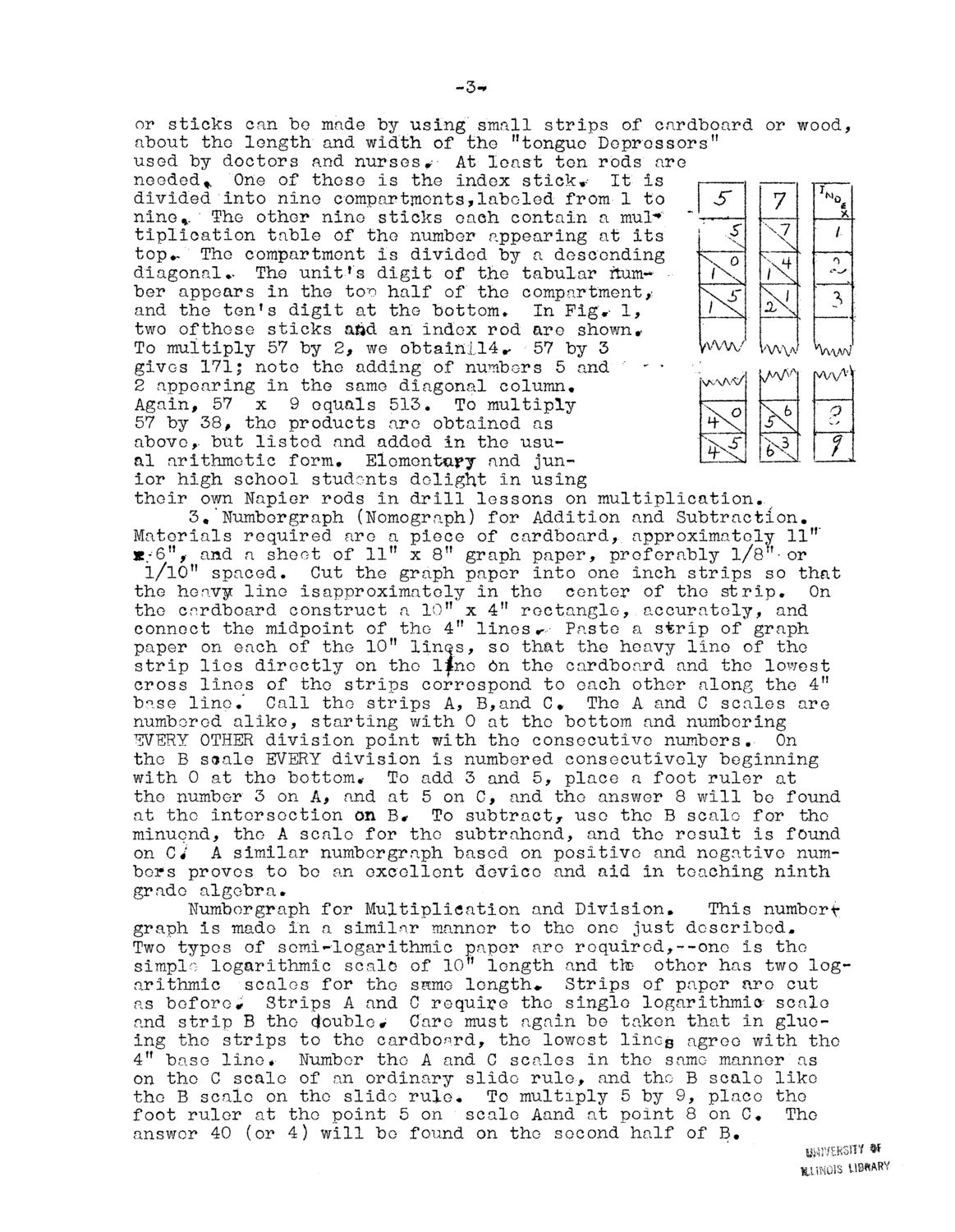| |
| |
Caption: Mathematical Models Construction and Use of Mathematical Models (Fehr & Hildebrandt)
This is a reduced-resolution page image for fast online browsing.

EXTRACTED TEXT FROM PAGE:
-3* or sticks can be made by using small strips of cardboard or wood, about the length and width of the "tongue Depressors" used by doctors and nurses* At least ten rods are needed* One of those is the index stick* It is divided into nine compartmonts,labeled from 1 to 1 s S I 7 nine % The other nine sticks each contain a mul^' . /1 1 s \7 tiplioation table of the number appearing at its j . \ \ top*.'" The compartment is divided by a descending 0 1 diagonals The unity's digit of the tabular f u - im* H N ber appears in the ton half of the compartment,3 X I K and the ten's digit at the bottom• In P i g * 1, two of these sticks &&d an index rod are shown* v w w ; l'Wv\ *Vv\A^/ To multiply 57 by 2, we obtainil4^ 57 by 3 gives 171j note the adding of numbers 5 and ' - * KaaA'^/ : V ^ w \ M / 2 appearing in the same diagonal column* o \ o V fe Again, 57 x 9 equals 513• To multiply '».> j IH^v i \ 57 by 3 8 , the products are obtained as above,, but listed and added in the usui k k LZJ al arithmetic form. Elementary and junior high school students delight in using their own Napier rods in drill lessons on multiplication 3# Numborgraph (Nomograph) of cardboard,-. and Subtraction a piece for Addition approximately llf Materials required are ." x 8" graph paper, preferably l / 8 " o r * * 6 % and a sheet of 11 1/10" spaced. Gut the graph paper into one inch strips so that the heavy line isapproximately in the center of the stripe On the cardboard construct a 10" x 4" rectangle, accurately, and connect the midpoint of the 4" linos r- Paste a strip of graph paper on each of the 10" lines, so that the heavy lino of the strip lies directly on the l^ne On the cardboard and the lowest cross lines of the strips correspond to each other along the 4" base line/ Call the strips A, B,and C* The A and C scales are numbered alike, starting with 0 at the bottom and numbering EVERY OTHER division point with the consecutive numbers. On the B soale EVERY division is numbered consecutively beginning with 0 at the bottom* To add 3 and 5, place a foot ruler at the number 3 on A, and at 5 on C, and the answer 8 will be found at the intersection on B* To subtract, use the B scalo for the minuend, the A scale for the subtrahend, and the result is found on C j A similar numbcrgraph based on positive and negative numbers proves to be an excellent device and aid in teaching ninth grade algebra* Numbergraph for Multiplication and Division* This numbert graph is made in a similar manner to the one just described* Two typos of semi^logarithmic paper are r e q u i r e d , — o n e is the simple logarithmic scalo of 10" length and tto other has two logarithmic scales for the smmo length* Strips of paper are cut as beforei Strips A and C require the single logarithmic- scale and strip B the double# Care must again be taken that in glueing the strips to the cardboard, the lowest lineg agree with the 4" base line* Number the A and C scales in the same manner as on the C scale of an ordinary slide rule, and the B scale like the B scale on the slide rule* To multiply 5 by 9, place the foot ruler at the point 5 on scale Aand at point 8 on C# The answer 40 (or 4) will be found on the second half of B , UBftARY &UMG.S
| |